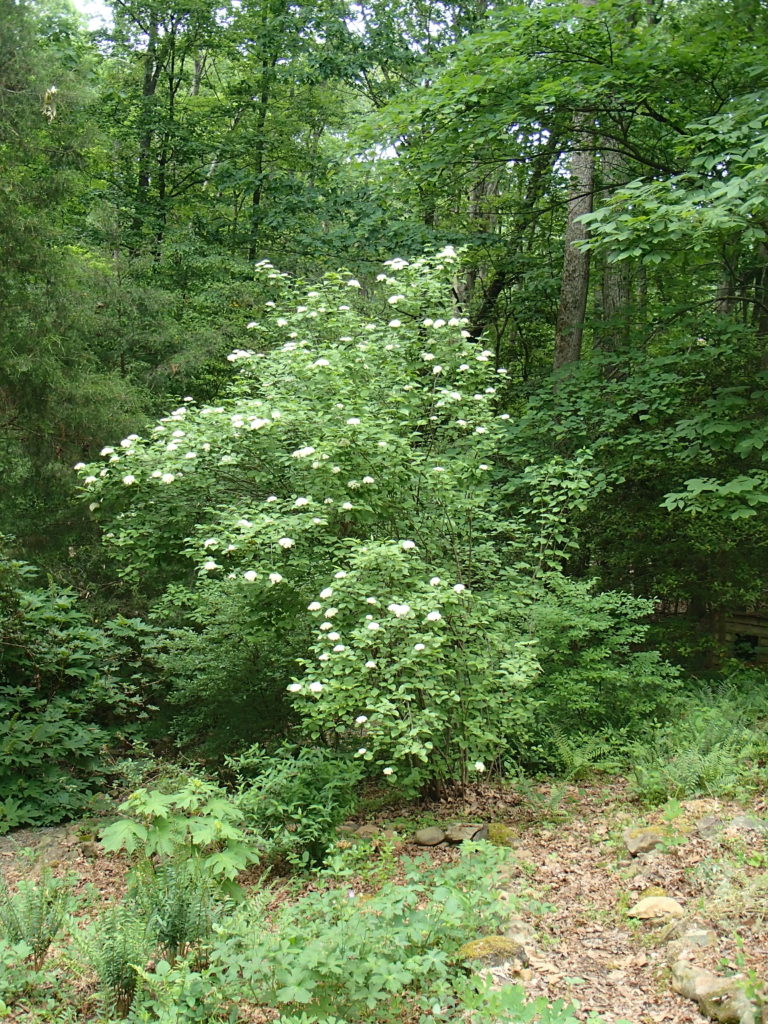Southern Arrowwood is a dense, 8-10-foot shrub native to Eastern U.S. It is composed of many upright, spreading, straight stems and bears typical-Viburnum 3-inch, flat-topped corymbs of small creamy white flowers followed in mid-summer by blue-black seeds which generously support a range of birds and other animals. It is so useful in the landscape because it is attractive to people and to critters, and is reliable, hardy and adaptable. It thrives in full sun or partial sun, tolerates acid to circumneutral soil pH as well as both flooding and relatively dry soil moisture conditions once established. Leaves are opposite and toothed (“dentatum”). Fall color is variable, often just yellows, but just as often, shades of orange and crimson. “They” say, the straight stems were once used as arrow shafts by native American Indians, hence the common name.
NURSERY HOURS
Wednesday: 10-4 Thursday: 10-6 Friday-Saturday: 10-4 Sunday: 12-4
Viburnum dentatum

Key Info
Scientific Name: Viburnum dentatum L.
Common Names: Southern Arrowwood, Arrowwood Viburnum
Family Names: Adoxaceae (Viburnum Family)
Plant Type: Tree / Shrub
Leaf Retention: Deciduous
Flower Color: White
Special Characteristics: Tolerates heat, Showy fruit, Tolerates urban pollution, Tolerates dry conditions, Tolerates flooding, Attracts butterflies, Tolerates Black Walnut, Attracts birds, Soil adaptable
Additional Info
Habit: Dense, upright, multi-stemmed shrub with straight, slender, arching stems and rounded crown, suckering at the base, bark grayish brown, medium texture. The root system is woody, shallow and branching, sometimes producing underground runners that form clonal offsets.
Height: 6' to 10'
Spread: 6' to 10'
Soil Conditions: Dry to medium to moist well drained soils, acid, sandy, loamy, clay.
Leaves: Opposite, simple, ovate, coarsely serrated, 2-4.5 inches long x 1-4 inches wide, lustrous dark green above, paler below, with prominent veins; short acuminate tip, while the base is rounded or cordate.
Flowers (or reproductive structures: Many small, weakly but not pleasantly fragrant (to humans!), creamy white flowers in flat-topped corymbs (to 4" diameter) that appear on the ends of leafy stems or short spur stems in late spring. The florets are ¼" across, with a 5-parted corolla, a very short calyx, 5 exserted stamens with yellow anthers, and a pistil with a single style.
Fruit: The flowers give way to ¼-inch blue-black, berry-like drupes in flattened clusters; each drupe contains a single stone (seed with a hard coat). These are quite attractive to birds and wildlife.
Natural Distribution: Woodland borders, streambanks, and fence rows.
USDA Hardiness Zone: 2 to 8
USDA Wetland Indicator Status in NC: FAC
Pollination: Bees, butterflies, other insects.
Wildlife Connections: The oddly scented flowers are of special value to native bees and bumblebees as well as flies and beetles. Butterflies and skippers may visit the flowers for nectar. Larval host and nectar source for the Spring Azure butterfly, and various moths, beetles and bugs. Its fruits are eaten by songbirds and gamebirds (including Eastern Bluebirds, American Robins, Gray Catbird, and the Northern Flicker, Grouse, Wild Turkey, Brown Thrasher, Northern Mockingbird, Pileated Woodpecker, Blue-Headed Vireo, and Swainson's Thrush) and mammals (such as Black Bear, Red Fox, Striped Skunk, Opossum, Fox Squirrel, Gray Squirrel, and White-Footed Mouse). The Indigo Bunting, Prairie Warbler, White-Eyed Vireo, and other songbirds sometimes construct nests in the branches of Viburnum spp. (for even more, see Illinoiswildflowers.info).
Propagation: By seed or by softwood cuttings in spring.
